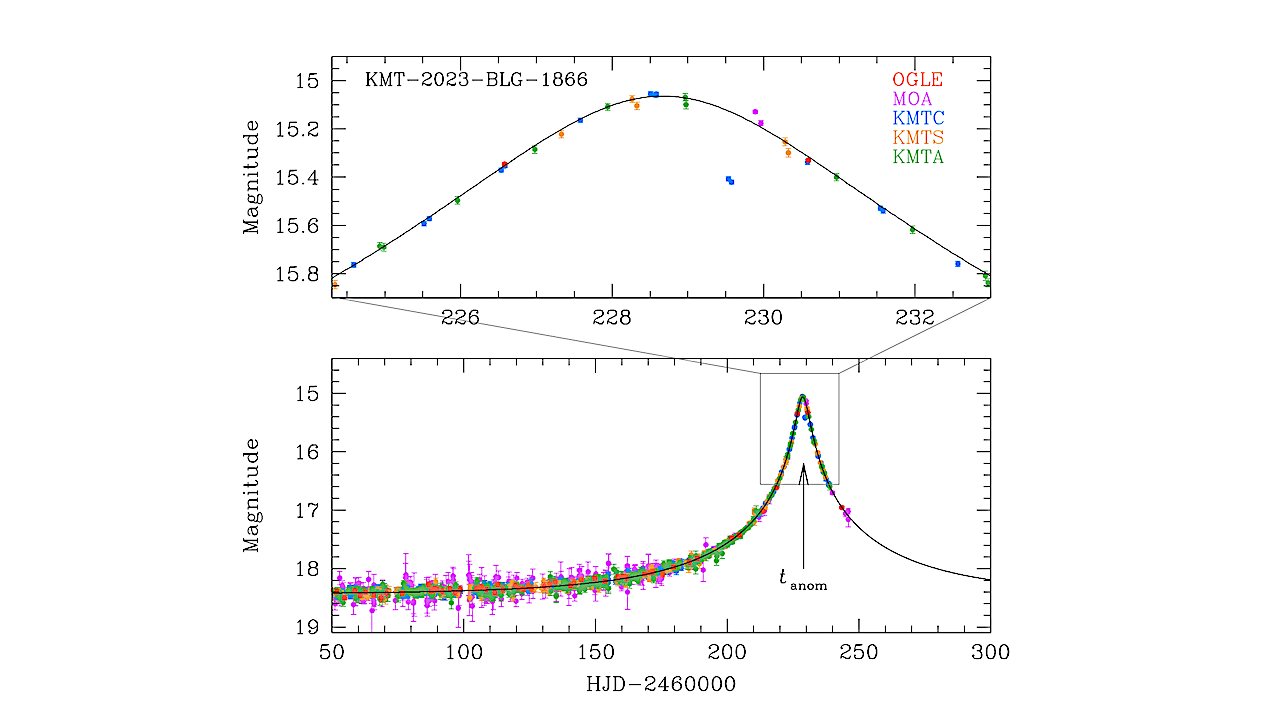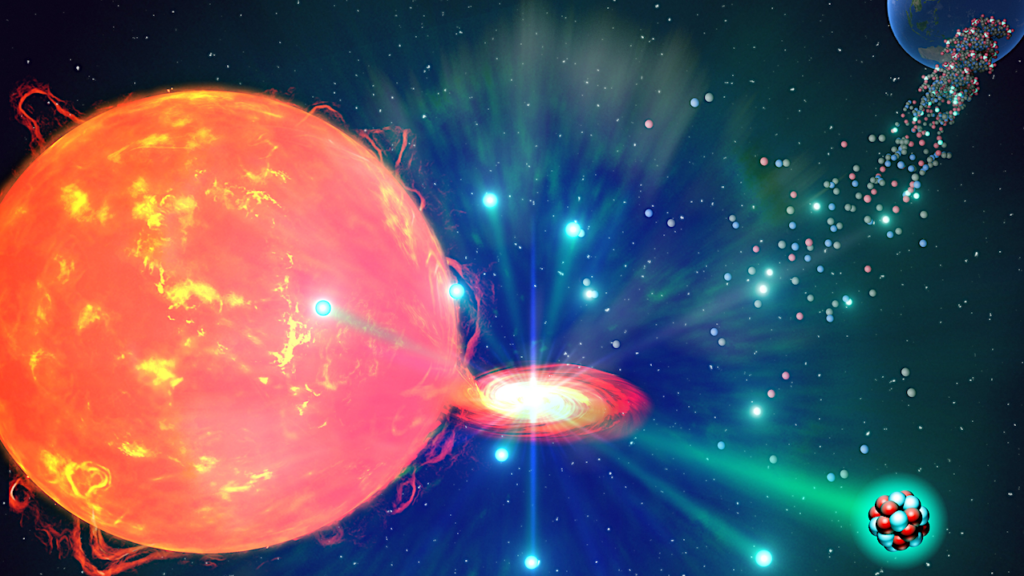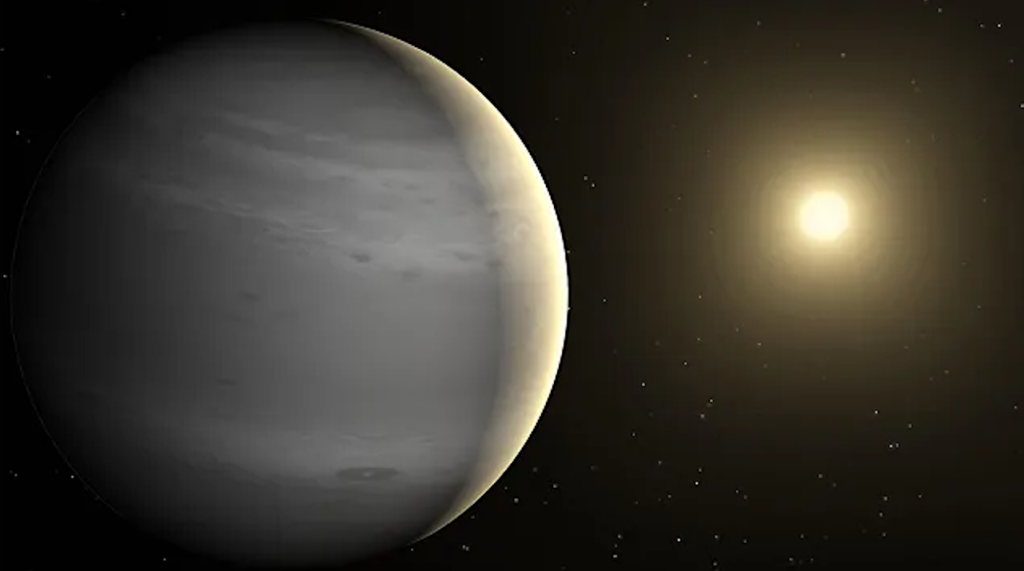KMT-2023-BLG-1866Lb: Microlensing Super-Earth Around An M Dwarf Host

We investigate the nature of the short-term anomaly that appears in the lensing light curve of KMT-2023-BLG-1866. The anomaly was only partly covered due to its short duration, less than a day, coupled with cloudy weather conditions and restricted nighttime duration.
Considering intricacy of interpreting partially covered signals, we thoroughly explore all potential degenerate solutions. Through this process, we identify three planetary scenarios that equally well account for the observed anomaly. These scenarios are characterized by the specific planetary parameters: (s,q)inner=[0.9740±0.0083,(2.46±1.07)×10−5], (s,q)intermediate=[0.9779±0.0017,(1.56±0.25)×10−5], and (s,q)outer=[0.9894±0.0107,(2.31±1.29)×10−5], where s and q denote the projected separation (scaled to the Einstein radius) and mass ratio between the planet and its host, respectively.
We identify that the ambiguity between the inner and outer solutions stems from the inner-outer degeneracy, while the similarity between the intermediate solution and the others is due to an accidental degeneracy caused by incomplete anomaly coverage. Through Bayesian analysis utilizing the constraints derived from measured lensing observables and blending flux, our estimation indicates that the lens system comprises a very low-mass planet orbiting an early M-type star situated approximately (6.2 — 6.5)~kpc from Earth in terms of median posterior values for the different solutions.
The median mass of the planet host is in the range of (0.48 — 0.51)~M⊙, and that of the planet’s mass spans a range of (2.6 — 4.0)~ME, varying across different solutions. The detection of KMT-2023-BLG-1866Lb signifies the extension of the lensing surveys to very low-mass planets that have been difficult to be detected from earlier surveys.
Cheongho Han, Ian A. Bond, Andrzej Udalski, Chung-Uk Lee, Andrew Gould, Michael D. Albrow, Sun-Ju Chung, Kyu-Ha Hwang, Youn Kil Jung, Yoon-Hyun Ryu, Yossi Shvartzvald, In-Gu Shin, Jennifer C. Yee, Hongjing Yang, Weicheng Zang, Sang-Mok Cha, Doeon Kim, Dong-Jin Kim, Seung-Lee Kim, Dong-Joo Lee, Yongseok Lee, Byeong-Gon Park, Richard W. Pogge, Fumio Abe, Ken Bando, Richard Barry, David P. Bennett, Aparna Bhattacharya, Hirosame Fujii, Akihiko Fukui, Ryusei Hamada, Shunya Hamada, Naoto Hamasaki, Yuki Hirao, Stela Ishitani Silva, Yoshitaka Itow, Rintaro Kirikawa, Naoki Koshimoto, Yutaka Matsubara, Shota Miyazaki, Yasushi Muraki, Tutumi Nagai, Kansuke Nunota, Greg Olmschenk, Clément Ranc, Nicholas J. Rattenbury, Yuki Satoh, Takahiro Sumi, Daisuke Suzuki, Mio Tomoyoshi, Paul J. Tristram, Aikaterini Vandorou, Hibiki Yama, Kansuke Yamashita, Przemek Mróz, Michał K. Szymański, Jan Skowron, Radosław Poleski, Igor Soszyński, Paweł Pietrukowicz, Szymon Kozłowski, Krzysztof A. Rybicki, Patryk Iwanek, Krzysztof Ulaczyk, Marcin Wrona, Mariusz Gromadzki, Mateusz J. Mróz
Comments: 9 pages, 8 figures, 4 tables
Subjects: Earth and Planetary Astrophysics (astro-ph.EP); Astrophysics of Galaxies (astro-ph.GA)
Cite as: arXiv:2405.07514 [astro-ph.EP] (or arXiv:2405.07514v1 [astro-ph.EP] for this version)
https://doi.org/10.48550/arXiv.2405.07514
Focus to learn more
Submission history
From: Cheongho Han
[v1] Mon, 13 May 2024 07:21:38 UTC (1,777 KB)
https://arxiv.org/abs/2405.07514
Astrobiology








